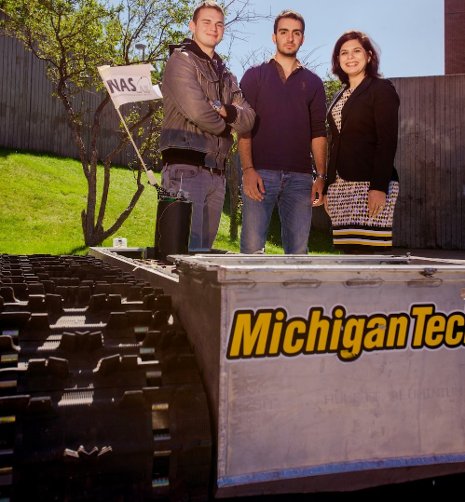Blackout? Robots to the Rescue

Nina Mahmoudian, right, with students Daryl Bennett, left, and Barzin Moridian. The team has demonstrated in their lab how robots can restore electricity after power outages. Next are real-world experiments using this life-size robotic vehicle.
Big disasters almost always result in big power failures. Not only do they take down the TV and fridge, they also wreak havoc with key infrastructure like cell towers. That can delay search and rescue operations at a time when minutes count.
Now, a team led by Nina Mahmoudian of Michigan Technological University has developed a tabletop model of a robot team that can bring power to places that need it the most.
“If we can regain power in communication towers, then we can find the people we need to rescue,” says Mahmoudian, an assistant professor of mechanical engineering–engineering mechanics. “And the human rescuers can communicate with each other.”
Unfortunately, cell towers are often located in hard-to-reach places, she says. “If we could deploy robots there, that would be the first step toward recovery.”
The team has programmed robots to restore power in small electrical networks, linking up power cords and batteries to light a little lamp or set a flag to waving with a small electrical motor. The robots operate independently, choosing the shortest path and avoiding obstacles, just as you would want them to if they were hooking up an emergency power source to a cell tower. To view the robots in action, see the video posted on Mahmoudian’s website.
“Our robots can carry batteries, or possibly a photovoltaic system or a generator,” Mahmoudian said. The team is also working with Wayne Weaver, the Dave House Associate Professor of Electrical Engineering, to incorporate a power converter, since different systems and countries have different electrical requirements (as anyone who has ever blown out a hair dryer in Spain can attest).
In addition to disaster recovery, their autonomous power distribution system could have military uses, particularly for special forces on covert missions. “We could set up power systems before the soldiers arrive on site, so they wouldn’t have to carry all this heavy stuff,” said Mahmoudian.
The team’s next project is in the works: a full-size, working model of their robot network. Their first robot is a tank-like vehicle donated by Michigan Tech’s Keweenaw Research Center. “This will let us develop path-planning algorithms that will work in the real world,” said Mahmoudian.
The robots could also recharge one another, an application that would be as attractive under the ocean as on land.
During search missions like the one conducted for Malaysia Airlines Flight 370, the underwater vehicles scanning for wreckage must come to the surface for refueling. Mahmoudian envisions a fleet of fuel mules that could dive underwater, charge up the searching robot and return to the mother ship. That way, these expensive search vehicles could spend more time looking for evidence and less time traveling back and forth from the surface.
The team presented a paper describing their work, “Autonomous Power Distribution System,” at the 19th World Congress of the International Federation of Automatic Control, held Aug. 24-29 in Cape Town, South Africa. Coauthors are Mahmoudian, Weaver, mechanical engineering graduate student Barzin Moridian, electrical engineering undergraduate Daryl Bennett and Rush Robinett, the Richard and Elizabeth Henes Professor in Mechanical Engineering.
Funding has been provided by Michigan Tech’s Center for Agile Interconnected Microgrids.
Michigan Technological University (www.mtu.edu) is a leading public research university developing new technologies and preparing students to create the future for a prosperous and sustainable world. Michigan Tech offers more than 130 undergraduate and graduate degree programs in engineering; forest resources; computing; technology; business; economics; natural, physical and environmental sciences; arts; humanities; and social sciences.
Media Contact
All latest news from the category: Power and Electrical Engineering
This topic covers issues related to energy generation, conversion, transportation and consumption and how the industry is addressing the challenge of energy efficiency in general.
innovations-report provides in-depth and informative reports and articles on subjects ranging from wind energy, fuel cell technology, solar energy, geothermal energy, petroleum, gas, nuclear engineering, alternative energy and energy efficiency to fusion, hydrogen and superconductor technologies.
Newest articles

Superradiant atoms could push the boundaries of how precisely time can be measured
Superradiant atoms can help us measure time more precisely than ever. In a new study, researchers from the University of Copenhagen present a new method for measuring the time interval,…

Ion thermoelectric conversion devices for near room temperature
The electrode sheet of the thermoelectric device consists of ionic hydrogel, which is sandwiched between the electrodes to form, and the Prussian blue on the electrode undergoes a redox reaction…

Zap Energy achieves 37-million-degree temperatures in a compact device
New publication reports record electron temperatures for a small-scale, sheared-flow-stabilized Z-pinch fusion device. In the nine decades since humans first produced fusion reactions, only a few fusion technologies have demonstrated…





















